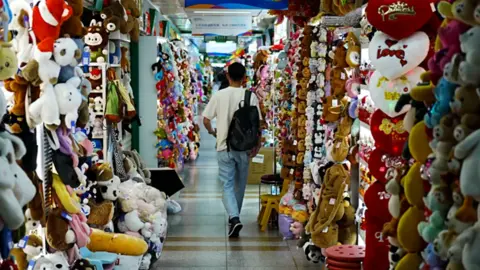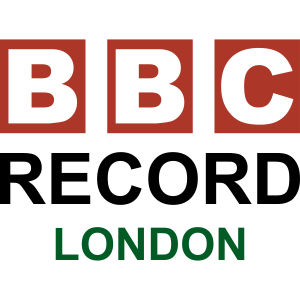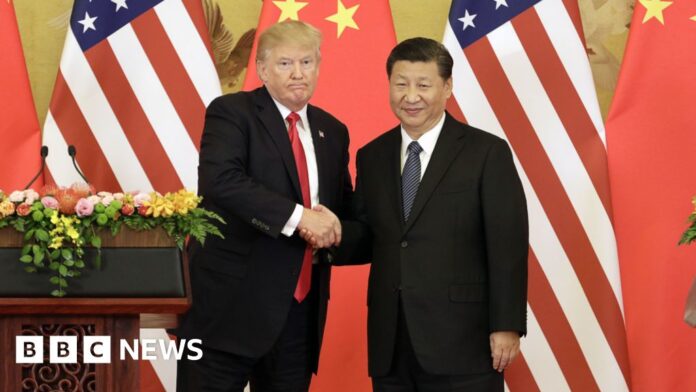China Correspondent
The US-China trade war could be letting up, with the world’s two largest economies beginning talks in Switzerland.
Top trade officials from both sides met on Saturday in the first high-level meeting since US President Donald Trump hit China with tariffs in January.
Beijing retaliated immediately and a tense stand-off ensued as the two countries heaped levies on each other. New US tariffs on Chinese imports stand at 145%, and some US exports to China face duties of 125%.
There have been weeks of stern, and sometimes fiery, rhetoric where each side sought to paint the other as the more desperate party.
And yet this weekend they face each other over the negotiating table.
So why now?
Saving face
Despite multiple rounds of tit-for-tat tariffs, both sides have been sending signals that they want to break the deadlock. Except it wasn’t clear who would blink first.
“Neither side wants to appear to be backing down,” said Stephen Olson, senior visiting fellow at Singapore’s ISEAS-Yusof Ishak Institute and a former US trade negotiator.
“The talks are taking place now because both countries have judged that they can move forward without appearing to have caved in to the other side.”
Still, China’s foreign ministry spokesperson Lin Jian emphasised on Wednesday that “the talks are being held at the request of the US”.
And the commerce ministry framed it as a favour to Washington, saying it was answering the “calls of US businesses and consumers”.
The Trump administration, however, claims it’s Chinese officials who “want to do business very much” because “their economy is collapsing”.
“They said we initiated? Well, I think they ought to go back and study their files,” Trump said at the White House on Wednesday.
 Getty Images
Getty ImagesBut as the talks drew closer, the president struck a more diplomatic note: “We can all play games. Who made the first call, who didn’t make the – it doesn’t matter,” he told reporters on Thursday. “It only matters what happens in that room.”
The timing is also key for Beijing because it’s during Xi’s visit to Moscow. He was a guest of honour on Friday at Moscow’s Victory Day parade to commemorate the 80th anniversary of the World War Two victory over Nazi Germany.
Xi stood alongside leaders from across the Global South – a reminder to Trump’s administration that China not only has other options for trade, but it is also presenting itself as an alternative global leader.
This allows Beijing to project strength even as it heads to the negotiating table.
The pressure is on
Trump insists that the tariffs will make America stronger, and Beijing has vowed to “fight till the end”- but the fact is the levies are hurting both countries.
Factory output in China has taken a hit, according to government data. Manufacturing activity in April dipped to the lowest level since December 2023. And a survey by news outlet Caixin this week showed that services activity has reached a seven-month low.
The BBC found that Chinese exporters have been reeling from the steep tariffs, with stock piling up in warehouses, even as they strike a defiant note and look for markets beyond the US.
“I think [China] realises that a deal is better than no deal,” says Bert Hofman, a professor at the East Asian Institute in National University Singapore.
“So they’ve taken a pragmatic view and said, ‘OK, well we need to get these talks going.'”
And so with the major May Day holiday in China over, officials in Beijing have decided the time is right to talk.
On the other side, the uncertainty caused by tariffs led to the US economy contracting for the first time in three years.
And industries that have long depended on Chinese-made goods are especially worried. A Los Angeles toy company owner told the BBC that they were “looking at the total implosion of the supply chain”.
 BBC/Xiqing Wang
BBC/Xiqing WangTrump himself has acknowledged that US consumers will feel the sting.
American children may “have two dolls instead of 30 dolls”, he said at a cabinet meeting this month, “and maybe the two dolls will cost a couple bucks more than they would normally”.
Trump’s approval ratings have also slid over fears of inflation and a possible recession, with more than 60% of Americans saying he was focusing too much on tariffs.
“Both countries are feeling pressure to provide a bit of reassurance to increasingly nervous markets, businesses, and domestic constituencies,” Mr Olson says.
“A couple of days of meetings in Geneva will serve that purpose.”
What happens next?
While the talks have been met with optimism, a deal may take a while to materialise.
The talks will mostly be about “touching base”, Mr Hofman said, adding that this could look like an “exchange of positions” and, if things go well, “an agenda [will be] set for future talks”.
The negotiations on the whole are expected to take months, much like what happened during Trump’s first term.
After nearly two years of tit-for-tat tariffs, the US and China signed a “phase one” deal in early 2020 to suspend or reduce some levies. Even then, it did not include thornier issues, such as Chinese government subsidies for key industries or a timeline for scrapping the remaining tariffs.
In fact, many of them stayed in place through Joe Biden’s presidency, and Trump’s latest tariffs add to those older levies.
What could emerge this time is a “phase one deal on steroids”, Mr Olson said: that is, it would go beyond the earlier deal and try to address flashpoints. There are many, from the illegal fentanyl trade which Washington wants China to crack down harder on to Beijing’s relationship with Moscow.
But all of that is far down the line, experts warn.
“The systemic frictions that bedevil the US-China trade relationship will not be solved any time soon,” Mr Olson adds.
“Geneva will only produce anodyne statements about ‘frank dialogues’ and the desire to keep talking.”




